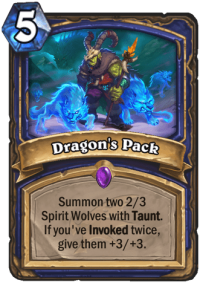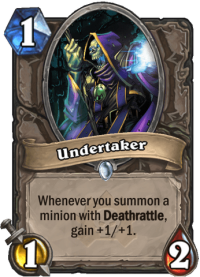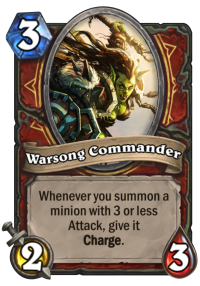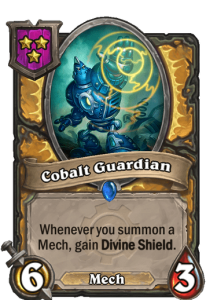For most Hearthstone players, the fact that Team 5 has shown a newfound willingness to regularly step in and adjust the meta is a positive – but even though it’s an objective improvement over the dark times when it took three months and the release of a new set to see a nerf to the dreaded Undertaker, there are certain downsides to stirring the pot on such a regular basis.
New Year, New Nerfs

It’s just as well that the 16.0.8 nerfs were just announced as I was writing this article. The latest round of updates continues hitting Galakrond Shaman which bounced back as a top tier deck in high Legend even after the initial impact of the last round of changes made. The developers have gone on record saying they feel like Galakrond decks are a bit overtuned overall, and Warlock and Warrior also had to suffer small nerfs to their support cards. Dragonqueen Alexstrasza can’t go infinite anymore, and no one in their right mind will complain about removing that level of highroll potential from Standard. Meanwhile, Necrium Apothecary was also adjusted, which feels like another knee-jerk reaction to Reddit complaints rather than a meaningful issue in the metagame. Just like the last round of nerfs, each individual change makes sense, but there’s a good argument to be made that there’s a bit too much of it going around.
 Back in the days of the open beta, many sweeping changes were made to cards in the Classic set, and it felt like a huge step back for many when Team 5 opted for a much more conservative approach after the game’s official launch. Not leaning into the digital nature of their game was widely considered to be a poor decision (and arguably one of the main reasons why Artifact sank without a trace as the developers initially committed to no nerfs whatsoever before quickly changing their mind in light of plummeting player numbers), and the way Ben Brode and co. hoped the GvG cards would solve the Undertaker problem from The Curse of Naxxramas (notably including two useless counter tools in the form of Lil' Exorcist and Scarlet Purifier to counter a card which snowballed by gaining +1/+1 for each Deathrattle instead of just +1 Attack) was definitely not the way to go.
Back in the days of the open beta, many sweeping changes were made to cards in the Classic set, and it felt like a huge step back for many when Team 5 opted for a much more conservative approach after the game’s official launch. Not leaning into the digital nature of their game was widely considered to be a poor decision (and arguably one of the main reasons why Artifact sank without a trace as the developers initially committed to no nerfs whatsoever before quickly changing their mind in light of plummeting player numbers), and the way Ben Brode and co. hoped the GvG cards would solve the Undertaker problem from The Curse of Naxxramas (notably including two useless counter tools in the form of Lil' Exorcist and Scarlet Purifier to counter a card which snowballed by gaining +1/+1 for each Deathrattle instead of just +1 Attack) was definitely not the way to go.
As the years went on, the growth of decktracking tools and strategy sites also meant that the community began to burn through the content at a much faster pace, leaving to mostly or completely solved metas halfway through an expansion cycle. This was one of the most significant complaints of veteran players in the past (alongside a lack of long-term targets or alternative game modes), and adjusting to this reality was one of the most promising moves made by the new Team 5 leadership over the course of the last year. The current approach also meshes better with the sort of pace mobile users have gotten used to in their games over the years, but it inevitably sacrifices a certain depth of the gameplay experience. Content shakeups like the Rise of Mechs and Doom in the Tomb events (problems with the latter notwithstanding) seem like a great solution, injecting new life into the metagame without releasing an entire new set and completely upending everything. However, once you throw multiple nerfs onto this pile even before the Galakrond’s Awakening adventure was even officially announced, one inevitably has to wonder whether there’s too much of a good thing.
The Downsides of Changing Too Much
 Speaking personally, I’ve always preferred playing in stabilized metas. While most players prefer the fun and excitement and the experimentation of the immediate post-release period, I simply just get frustrated knowing that I’m playing an unoptimized deck against a suboptimal play strategy over and over again simply because no one knows better. (It’s no coincidence that my relative competitive successes, including top 100 ladder finishes and almost-runs in the HCT qualification process, all came during metas where the newly released set didn’t have as much of an immediate impact on Constructed: the evolution instead of the revolution of the top decks are what allow me to find the edges others may miss out on). Of course, I am very much aware that I’m in the minority of the playerbase in this regard (hell, I play chess in my spare time, the manual kind, just to make things even worse), and even I considered events like Rise of the Mechs a pure positive change in Team 5’s design philosophy.
Speaking personally, I’ve always preferred playing in stabilized metas. While most players prefer the fun and excitement and the experimentation of the immediate post-release period, I simply just get frustrated knowing that I’m playing an unoptimized deck against a suboptimal play strategy over and over again simply because no one knows better. (It’s no coincidence that my relative competitive successes, including top 100 ladder finishes and almost-runs in the HCT qualification process, all came during metas where the newly released set didn’t have as much of an immediate impact on Constructed: the evolution instead of the revolution of the top decks are what allow me to find the edges others may miss out on). Of course, I am very much aware that I’m in the minority of the playerbase in this regard (hell, I play chess in my spare time, the manual kind, just to make things even worse), and even I considered events like Rise of the Mechs a pure positive change in Team 5’s design philosophy.
Having a built-in shakeup in the middle of every expansion is a great thing, and as long as they’re kept as relevant and meaningful moments, they will naturally create a “before” and “after” snapshot in the community’s mind. However, if you add multiple nerfs to the equation, the timeframe between changes in the Constructed environment actually becomes pretty short, leaving much less room for mastery. Knowing that your deck could be nerfed in a few weeks’ time and then rendered useless by an event even if it survives makes experimentation a lot more daunting for F2P and low-budget players as well, not to mention how it severely impacts the fun for those select few of us who prefer playing with optimized decks against one another with clear strategic lines already established. And ultimately, if your fancy new set with all those powerful cards had to be followed by two sets of nerfs in a month’s time, doesn’t that reflect poorly on your product as a card game designer?
In fact, this is likely a part of why the overbearing community sentiment about the current Standard Constructed experience can be summed up as ‘meh’ so far. As much of a hype-damaging period it was to have Galakrond Shaman run riot at the start of the expansion, Battlegrounds picked up the slack, perhaps even more so than Team 5 would have preferred it. After they’ve made a systematic effort to reduce the replayability of the single-player content since Dungeon Run to push people back towards the ladder environments, one has to wonder how they’ll manage the impact of a PvP mode which doesn’t check for the players’ collection.
Small and regular changes make much more sense in that environment, and having such a large pool of potential cards and heroes to rotate in and out of the format (with the ability to design new ones from scratch with little effort) gives Battlegrounds a big leg up on other autobattler titles. It’ll go stale just as fast, if not faster, as its competitors but has much more convenient ways to spice things up. There’s also even less of an incentive to take competition seriously.
Of course, Spikes (to quote Magic’s term for the tryhard players) were always the red-headed stepchildren of the Hearthstone community. Entire game modes like Wild or the Arena are completely ignored, Battlegrounds was launched with a faulty MMR system with no intention to do a ranked reset after massive chasms were established by it at launch and the lack of an in-game tournament client has severely limited the possibilities of online competition over the years. Changing the meta three to five times in an expansion cycle may be fun for the casuals, but it gives even less reasons for those who play to win to take things seriously. When Magic’s new player numbers were flagging in the mid-noughties, the solution was to reduce entry-level complexity and costs, not to throw around a million erratas and nerf everything to the ground. Hearthstone’s design always leaned towards pre-baked archetypes instead of strong viable independent cards – even more micromanagement may not be the answer to the game’s current difficulties.


I’ve stopped playing Constructed almost entirely as a result of the ever increasing pace of nerfs, myself. I like for things to develop naturally, and to really learn the ins and outs of both the met and my chosen deck over time. I also like being able to invest in a given deck or archetype over time, but with nerfs being so frequent and sometimes targeted not against truly broken decks but against decks that result in a lot of player complaints, I don’t feel save investing in cards anymore. My spending has plummeted on the game accordingly, when I used to pre-order every set (often twice, for gifts, even).
I’ve never much liked nerfs to begin with though: my preference would always be for standard bans/Hall of Fame to be the lever used, and only against truly format-warping decks. Not being able to go back to old cards even in Wild because nerfs are often so severe as to kill cards is very frustrating, too.
So while the community as a whole is always really glad for their coveted meta shakeups, the constant nerfs and changes are making the game less fun for me overall.
Did you forget about Witchwood and Rasthakan nerfs? They practically killed all the good decks in the format (Cube and Control Warlock, Even Paladin, Spiteful Druid, Quest Rogue, Maly and Tog Druid, Shudderwock Shaman, Odd and KB Rogue, some slower Hunter variants, etc). Blizzard should respect the cards they just printed more and ban them for standard-only only when they are really really problematic. Banning is better than nerfing because while unbanning is easy, unnerfing happened just once (molten giant docet). The last time I truly enjoyed playing HS was in the year of the mammoth, before and after the Raza/Patches and the Jade/FWA nerfs. Back then there were actually good cards to play with and the meta was enjoyable both in ladder and tournaments (Medivh, N’zoth, Cubelock, Raza, Fatigue Warrior, Control Warlock, Zoolock, Jade Druid, Tempo Rogue, OTK / N’zoth Paladin, Control Mage, Combo Priest, Quest Druid, Big Druid, Quest Mage, Pirate Warrior, Evolve Shaman, etc etc Conquest Bo5 in tournaments). Honestly the truth is that HS has become disgusting with the release of Witchwood and that’s why I’ve switched back to MTG (arena is great value for time and for money and reaching mythic in the first week of the month actually mean something; the economy of the game also isn’t rigged).
What do you mean the economy of MTGA is not rigged? For all the bashing it gets, the Hearthstone economy is actually much better in the long run than MTGA’s. You can dust your useless cards for 1/4 of the value, whereas in MTGA your 5th copy of a card is worth muuuuuuuuch, much less. Not to mention that when starting that game you need to invest precious Rare cards in… LANDS (equivalent of Hearthstone’s mana crystals) just so you can START being competitive.
I actually find metas themselves kind of boring… back in ye olde days, when I played physical MtG against friends, half the fun was caused by card scarcity – there was no meta, you built what you could with what you had. Well, I suppose there was sort of a meta, if I was playing mono-Black the odds were I’d be using a sacrifice deck with Breeding Pit and Lord of the Pit – because I had them – and my friends would know that I guess.
… but the number of games of HS I’ve had where one or the other of us has conceded just based on the opening one or two turns of a game, is ridiculous. “That’s a strong start for Face Hunter” – concede. “Oh, Priest” – concede (note: I hate playing priest, for or against).
Once the meta has settled you can often know whether you’ve won or lost within the first few turns – the rest of the game is just going through the motions. I guess that’s why I like my home-brewed combo decks so much… OTK is the ultimate swing if they don’t see it coming.
Shaman Galakrond went from top to bottom tier. That’s no small balance change! And now hunter and/or rogue sits on top of the meta by a margin. The outcome is that class x got replaced by y, so what’s the point? Is it really about balance or is it a money making strategy by Blizzard?
There are 14 decks listed in the HSTD tier list, more than that on HSReplay. Only one of them changed significantly. And that may not be permanent, as people find better ways to play it.
Since Blizzard is a for-profit company, everything it does is about making money. But why does that have to be a bad thing? Doesn’t a game company make money by making its games fun over the long term?
I’d say that if you’re trying squeeze people, nerfing a bunch of Epics and a Legendary and giving them a lot of dust is not the way to do it.
I enjoy playing in a settled meta, also. I like having a good feel for what a deck can do, what its possibilities are, and trying to match that against the known capacities of the other common decks.
That being said, I’d like to mention a few points:
a) There needed to be some adjustments this time. Maybe not quite so many, but there were definitely some overpowered cards that needed to be tuned down.
b) These changed haven’t resulted in overturning the entire meta. The range of decks available is pretty similar throughout. So there isn’t as much change and inconsistency as you would think from the amount of complaining there is.
c) I think the developer made some really great points in his discussion of the philosophy behind the balance changes. First, they want to be willing to take risks, and sometimes, your risks aren’t going to work out (Evolve, Galakrond Shaman). I think that’s a great approach. Second, he said they are trying out different strategies and seeing how they work, how people like them. That’s also a great approach. They aren’t just doing the same old thing because that’s what’s always been done.
Long story short, I think these changes are the result of a good process. Sometimes a good process, one that’s experimental and not risk-averse, comes out with things people don’t like. But that’s life! I don’t really think it’s as bad as some people seem to think it is.
I am with you on most of this. I believe that a stable meta should at least reign for a month or a month and a half. While I love the deck building phase after a shake up (and while I even perform at my best during that time), I think the really good players shine in a settled meta. The problem is that for the hard core players who spend six hours a day gaming that might be a bit dull. Especially since only a small minority of them get to play at a really competitive level.
I don’t mind a settled meta and love testing home brews on ladder against ruling decks. There will always be more popular and better decks than others. A settled meta adds the strategic level of tech cards and counter decks which is lost in a constantly changing environment. As you mentioned mtg, I remember when playing a tournament, any deck you played had to be equipped against a hymn into hypno opening. still there were many other decks played competitively.
Whats a hymn into hypno opening? I know hymn to tourach but whats hypno? Hypnotic specter?
Yep. And I meant it the other way around. 😉 ritual hippie, next turn hymn. Half your hand gone. 🙂
Blizzard is here to make money but this movement is dangerous as many players (me included) may consider left the game. I’ve dusted all Shaman cards from Year of Raven sets as the class is unplayable right now to get some dust before the new Standard Year.
Well yes, for profit companies try to make profits. Profound.
I just play battlegrounds until it settles considerably after the last nerf. If that never happens then it’s just more battlegrounds. RIP standard